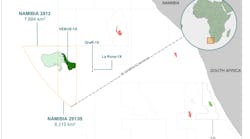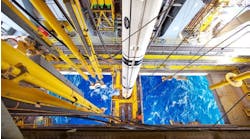Expandable liner hanger enhances North Sea casing directional drilling program
READ Well Services has implemented a series of world firsts in the use of the hydraulically expandable tubular system (HETS) on a well in the Norwegian sector of the North Sea.
This advanced HETS-LH (liner hanger) was developed in response to a challenging well construction project in the Norwegian sector of the North Sea. Development took 14 months from concept to implementation in the Norwegian well. The liner hanger installation was completed and confirmed as successful by a pressure test.
Using this system allowed the bottomhole assembly to be recovered during the drilling phase.
Because the hanger has no moving parts and a unique combination of metal-metal interference fit and elastomer seals, it is expected that performance reliability will be significantly improved compared to conventional hangers.
Extensive onshore testing demonstrated that the hanger could withstand up to 360 tons bi-directional load; and testing to 5,000 psi in accordance with the ISO14310 V0 (Packer) Test had established gas seal capability of the liner hanger, the company says.
Space-saving flow meter for FPSO vessels
McCrometer has developed a space-saving V-Cone FPSO flow meter for liquid, gas or steam measurement on cramped floating production, storage and offloading vessels operating in deepwater or remote areas.
The flow meter’s no-moving-parts design provides built-in flow conditioning, which nearly eliminates the upstream/downstream straight pipe runs required by most flow meters.
McCrometer has developed a space-saving V-Cone flow meter for liquid, gas or steam measurement on cramped FPSOs operating in deepwater or remote areas.
Typical flow meter installations require 10 to 40 straight pipe diameters upstream from the meter and five or more straight pipe diameters downstream to eliminate the effects of swirl and other disturbances caused by valves or elbows that negatively affect pipeline measurement accuracy.
The flow meter reduces straight pipe run requirements by up to 70% or more and needs 0-3 straight pipe diameters upstream and 0-1 downstream to operate effectively, the company says. It fits tight installations aboard FSPO vessels as well as in subsea applications, while reducing pipe material costs and installation labor costs dramatically. The pool operates over a wide flow range of 10:1 and supports line sizes from 13 to 3,048 mm (0.5 to 120 in.) and requires virtually no recalibration or maintenance over its life. Accuracy is +0.5%, with a repeatability of +0.1%, McCrometer says.
The meter is compatible with standards set by the oil/gas production, delivery, and refining industry. Testing of the flow meter conformed to the American Petroleum Institute’s API 22.2 Testing Protocol for differential pressure flow measurement devices, the company says.
Unlike traditional DP instruments such as orifice plates and venturi tubes, the flow meter design is more accurate because the flow conditioning function is built into the basic instrument. The V-Cone conditions fluid flow to provide a stable flow profile to increase accuracy. It features a central cone inside a tube that interacts with the fluid flow to reshape the velocity profile, creating a lower pressure region immediately downstream.
The pressure difference, which is exhibited between the static line pressure and the low pressure created downstream of the cone, can be measured via two pressure sensing taps. One tap is placed slightly upstream of the cone, and the other is in the downstream face of the cone itself. The pressure difference can be incorporated into a derivation of the Bernoulli equation to determine the fluid flow rate, McCrometer says.
The cone’s central position in the line optimizes the velocity of the liquid flow at the point of measurement. It forms very short vortices as the flow passes the cone. These short vortices create low amplitude, high frequency signals for excellent signal stability. The result is a stable flow profile that is repeatable for continuously accurate flow measurement.
Solid expandable systems
Weatherford International Ltd. has developed a solid expandable system named MetalSkin for open- and cased-hole applications. Weatherford says it has focused in recent years on breaking barriers to the technology’s adoption, which will help make many of today’s capital-intensive wells economically viable.
The company developed four MetalSkin systems: 1) open-hole liner; 2) monobore open-hole liner; 3) cased-hole liner; and 4) monobore open-hole clad. Most of these systems can be used for multiple applications to address both pre-planned and remedial well construction.
According to the company, solid tubular expansion is one of the most important enabling technologies for the future of the oil and gas industry. Significant downhole testing has been completed, and on Feb. 14, 2007, approximately 305 m (1,000 ft) of the 299 mm x 340 mm (11 3⁄4-in. x 13 3/8-in.) MetalSkin monobore open-hole liner was successfully installed in a test well. This installation proves that there are new ways to solve drilling challenges without losing hole size, Weatherford says.
New fishing tools
The Logan Superior hydraulic fishing jar is a straight pull, up only, jarring tool with a special valve section to meter oil from one chamber of the piston to the other chamber for controlled jarring action during a stuck fish recovery. The operating chambers are sealed and isolated from each other to protect from contaminating the metering section and the well.
During downhole operation, the jarring blow is infinitely adjustable without any rig floor adjustments necessary prior to the run, the company says. The straight pull load applied by the operator controls the intensity of the jarring blow; a light pull load delivers a light blow, while a heavier pull load delivers a heavier blow. Pull load is varied to change the jarring blow.
Since oil is not metered during re-cocking, only a very light load (enough to overcome friction) is required. The light re-cocking load allows a rapid series of blows if needed to free a stuck fish. The fishing jars are hydrostatically pressure balanced with maximum inside diameters to permit passage of wireline tools. Its large mandrel design makes it suited for fishing, milling and washover operations.
When maximum jarring impact and impulse are needed such as in shallow, deviated, or directional holes where acceleration and effectiveness of movement is diminished, the Energizer tool can be run in conjunction with the fishing jar, the company says. This device is a fluid spring that stores energy when strain is applied to the fishing string. It offsets the loss of stretch or drag on the string and allows energy to be stored immediately above the drill collars and the fishing jar to increase the impact energy.




